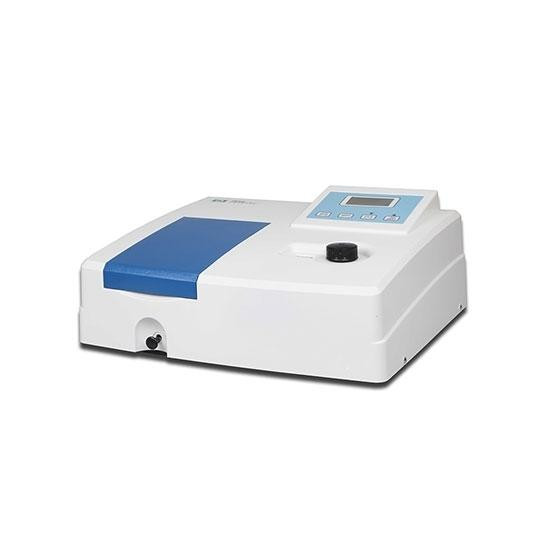The Spectrophotometer is an optical device that measures light intensity in relation to wavelength. The holographic grating separates the electromagnetic energy gathered from the sample into its component wavelengths when it enters the device through the aperture (yellow line). To put it another way, the grating separates each colour from the white light. The split light is then focussed into a CCD array detector, where each pixel measures the strength of each wavelength (or colour if in the visible zone). After reading the CCD into a computer, the outcome is a spectrum that shows the strength of each wavelength of light.
A spectral measurement of the visible range, which humans perceive as colour, is an example. When white light enters the monochromator, it is split into a rainbow of colours. This rainbow would be centred on the CCD, with blue light on one end and red light on the other. The intensity of a colour would then be measured by each pixel of the CCD. As a result, a spectrum like the one below would emerge. The blue pixels emit blue light, the green pixels emit light in the green spectrum, and the red pixels emit red light, as depicted.
By illuminating a sample and measuring the intensity of light returned from the sample relative to its wavelength, the Spectrophotometer allows the researcher to obtain spectra. Measurements can be conducted using light transmitted through the sample, reflected from it, or even when the sample is manipulated to generate light by processes like photoluminescence using this non-destructive technique. The UV-visible-NIR range is particularly relevant because more chemicals absorb in the UV than in the visible and infrared ranges, including colourless molecules. As a result, a Spectrophotometer with a UV-visible-NIR range is particularly useful for analysing most substances in any application.
Spectrophotometer are used in a variety of sectors and can be found in both research laboratories and manufacturing plants. They're utilised for quality control in the manufacturing environment, for example, on everything from apparel to the emission of light while making LEDs. Analytical laboratories utilise Spectrophotometer to identify and quantify microscopic materials in a variety of applications, including kinetics, colour matching, gem and mineral qualification, and the colour assessment of ink or paint by a process chemist. As a result, the spectrometer is a versatile instrument with a wide range of uses.
Spherical Spectrophotometer can calculate colour measurements that closely match what the human eye sees by measuring light reflected from all angles. They're frequently used to measure colour applied to textured materials like fabrics, carpets, and plastics, as well as shining or mirror-like surfaces like metallic inks, foil printing, and other extremely glossy surfaces.
Every industry that requires precise colour uses Spectrophotometer. These devices ensure that the colour being produced matches the colour that was originally specified the first time, every time, reducing waste and saving you time and money. “From cardboard packaging to laundry soap to carpeting and small plastic parts, these devices help ensure that the colour being produced matches the colour that was originally specified the first time, every time, reducing waste and saving you time and money. We see X-Rite as a key partner in our ability to grow and continue to meet our customers' expectations. We've always had positive experiences with X-Rite and GretagMcBeth products, and the new Ci7800 is no exception.
Inside the machine, a monochromator (such as a prism or grating) refracts light into a single spectrum and disperses polychromatic light into key wavelengths. The light accessible is divided into separate portions by a grating. Spectrophotometer that employ the UV, visible, and infrared ranges frequently use gratings.

